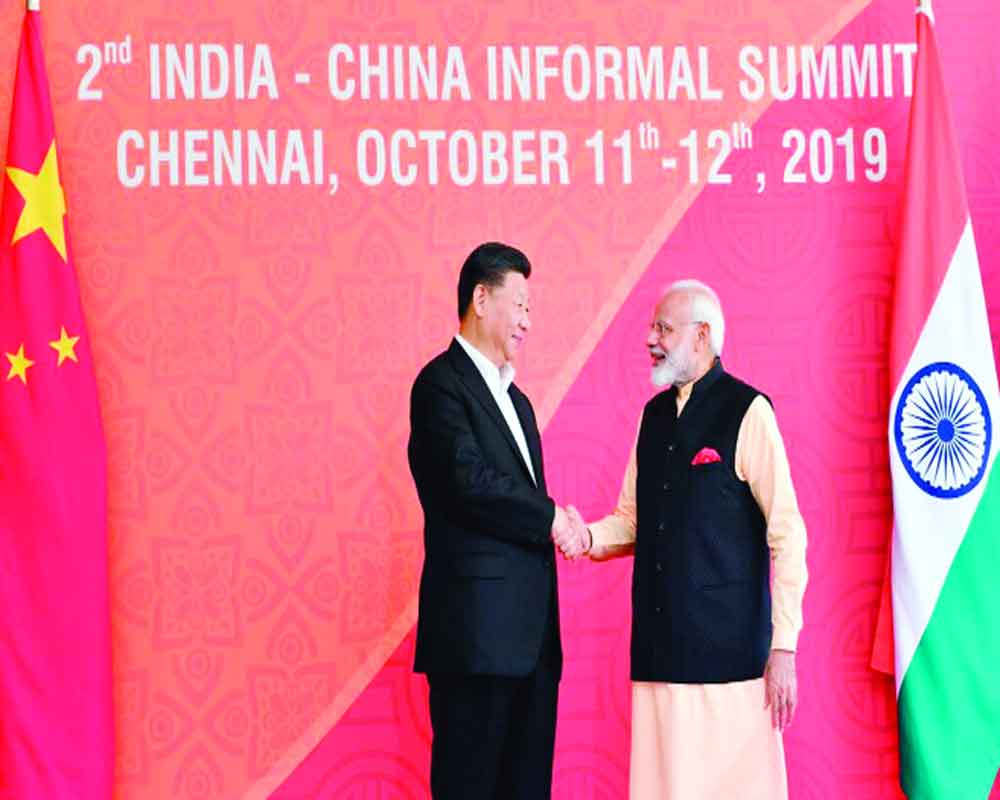Modi and Xi have settled down on a new grammar of negotiation despite trust issues over historical baggage
There were optics aplenty, of sipping coconut water, sightseeing tours of heritage sites, lavish local dinner, culture shows, long walks and an umbrella swamp of Indian hospitality. But Chinese President Xi Jinping, a hard-boiled supreme leader of his nation with aspirations to be the hegemonic anchor of an Asian century, is hardly expected to find India incredible enough. However, he does realise its materiality in the Chinese design and its bridge value with the rest of the world. Yes the informal summit in Mamallapuram, as it did in Wuhan, did enable both him and Prime Minister Narendra Modi to use their personal equation as a showpiece of neighbourhood understanding and co-existence. It did help in simmering down tension, then over Doklam and now Kashmir, but this relationship hereon will be one based on realism rather than expectation, need-based practicality rather than high-sounding hyperbole. To that extent, there’s a new “connect†as Modi said and a “heart-to-heart†candour as Xi admitted. India cannot expect China to abandon Pakistan on its terms. Xi has to stand by his all-weather ally and cannot de-couple Kashmir to the extent that its changed status and talk of reoccupying lost territories in Pakistan-occupied Kashmir (PoK) have left it worried about Shaksgam Valley, which Pakistan ceded, and Aksai Chin. But now that India has the larger world opinion on Kashmir as its internal matter, including that of the US, China realises its strategic heft. It further realises that pushing the People’s Liberation Army (PLA) mischievously for border incursions won’t work anymore. Which is why Modi, too, confidently announced that there would be no further escalation of disputes. India has now stared back at that threat to its territorial integrity and even resisted all attempts to be encircled by China’s Belt and Road Initiative (BRI). Not only that, by engaging with multi-lateral fora like the Quad and even Southeast Asian nations bilaterally, India has subtly but determinedly challenged China’s diplomatic sway in the region. Besides, Xi had watched the “Howdy Modi†event in the US closely and wanted a counter-optics, if not a counterweight. Given its trade tussle with the US, China also needs India’s absorptive market to keep its momentum. Besides, it is itself under international scanner on its rights issues with the Uighur Muslims, Hong Kong and Tibet and does not want to face a counter-charge of violating UN resolutions, considering that the China-Pakistan Economic Corridor (CPEC) in Gilgit-Baltistan is in disputed territory, too. No wonder Xi kept away from mentioning Kashmir. While China realises that Pakistan can only be Kashmir-centric, forcing it into embarrassing posturing, he has figured out larger issues for the bilateral arc. Without mentioning Pakistan, Modi and Xi did discuss combatting terrorism and radicalisation. This is a small but forward-looking tweak.
Trade is the biggest takeaway despite China’s simultaneous breakthrough with the US on the subject. The mutual deficit there is nearly $400 billion and President Donald Trump would want to appear tough in an election year. So China would still need a big market like ours. Xi seems ready for sincere action to address our trade deficit, which stands at $53.56 billion out of a two-way trade of $87 billion. In its desperation to make India sign the mega free-trade pact, Regional Comprehensive Economic Partnership (RCEP), China has agreed to a high-level, trade-facilitator mechanism. From China, it will be led by the Vice Premier, Hu Chunhua, and from India it will be Finance Minister Nirmala Sitharaman. At least now, there is a seriousness about a give-and-take rather than just a dump-your-goods formula. There will also be an attempt to fatten up the import basket from India. Besides defence cooperation is what China is looking for as a lucrative option. Of course, New Delhi has to look into byproducts like a glut of Chinese goods in an open market scenario, issues of security and spying if allowing Huawei and so on. Much depends on the volume and nature of Indian goods and services that China allows in its home market. Still, there is a consensus on both sides that confrontation between the two economies could only harm both. Also, by citing historical trade routes, both nations feel that they can together command the world economy like they did in the past. What is good about Mamallapuram is that there is an open acceptance of wrinkles in the silk that Modi gifted and also a solution offered in the form of “strategic communication†which both sides want to continue. Of course, they must be implemented, too. Trust may not be easy to earn given the baggage of boundary issues but surely there is a new grammar of negotiation.


























